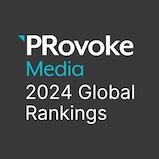Paul Holmes 28 Jun 2013 // 5:33AM GMT
It should go without saying that one of the most critical aspects of any campaign is whether it worked. Yet demonstrating that your campaign was truly successful—that it not only generated a lot of coverage, but that the coverage contributed to the organization’s bottom line—remains a challenge for many companies.
Our SABRE Awards judges are experienced professionals, and so they understand that many clients don’t provide the necessary resources for most meaningful kinds of measurement; some are even reluctant to share data relating to business results with their agencies, or with awards judges. Those judges also know that proving a direct cause-and-effect relationship between a particular campaign (or the PR component of that campaign) and an increase in sales, for example, is often difficult.
At the same time, they look for some sign that the PR team has done its best to provide the most robust metrics possible. This article attempts to list the various metrics we see from least significant to most impressive. It’s certainly possible for a great campaign—one with a smart strategy, a brilliant creative idea, and flawless execution—to win even if the measurement falls at the low end of this “ladder”—but it’s much easier to win if you can provide some sort of measurement at the higher end.
- Volume of media coverage. We certainly understand that getting media coverage is a challenge. The ability to generate a lot of coverage—measured by the number of clips, the reach, “opportunities-to-see” and other metrics—is a valuable skill. But media coverage should not be an end in itself; there should always be some attempt to demonstrate that the media coverage resulted in some change in awareness, attitude or action that was of benefit to the client.
- Quality of media coverage. Many clients set specific objectives for media coverage in terms of prominence, tone, brand mentions, etc. This is an improvement over the simple act of counting clips or measuring column inches, but it still falls short of demonstrating an impact on the business.
- Advertising equivalency. There are some measurement experts who are so viscerally horrified by advertising equivalency—the act of measuring the value of media coverage by how much it would have cost to buy the same volume—that they would rank it below simply counting clips. Yet this measure remains popular among some marketers, because they believe it allows them to compare PR to advertising in a direct way. Again, this form of measurement does nothing to demonstrate that the media coverage in question achieved anything for the client’s business.
- Awareness. There are very few instances when “awareness” is a sufficient objective. If you are launching a new product or a new initiative, awareness can be an important first step, but ultimately it matters very little unless that awareness translates into action. Still, awareness helps to show that your activities (media coverage, social media outreach, events, etc.) are getting through to the intended audience. But if you claim awareness as an objective, you need to show awareness in the results, which usually means pre- and post-campaign research. Don’t say your objective was to raise awareness and then measure success by how much coverage you generated.
- Shareability. In the digital realm, it’s now possible to measure the extent to which campaign elements are shared by readers or viewers. It is important for public relations professionals to understand and use metrics such as clicks-per-share and shares-per-view, all of which suggest that PR activities engaged the interest of the audience—even if forwarding or sharing a viral video, for example, falls some way short of demonstrating genuine engagement with the brand or the company behind it.
- Attitude. One step beyond raising awareness is changing attitudes. It demonstrates not only that your message reached its intended audience, but that it was persuasive enough to change their mind about a product, company, or issue. But again, changing attitudes don’t automatically translate into changing actions: many consumers claim to favor more sustainable products and companies, but relatively few follow through when it comes to actual purchases; more than 90 percent of Americans favor some sort of gun control, but they are not yet engaged enough on this issue to force politicians to change their positions.
- Engagement. One great thing about the rise of digital and social media is that they allow companies to measure engagement—the extent to which the audience was moved by a campaign—in a variety of ways. An increase in the number of Facebook fans and/or Twitter followers is nice; even more impressive is the ability to measure an increase in conversation and/or a change in the tone of conversation—though it is important to remember that friends and followers don’t necessarily have a dollar value.
- Advocacy. There’s actually a case to be made that this should be at the top of our sliding scale of quality metrics, that increasing the number of brand advocates (and minimizing the number of brand critics) should be the objective of every public relations initiative. There’s plenty of evidence to suggest a direct correlation between brand advocacy and business performance, enough to make this an impressive metric. If you can show an increase in the number of people recommending your company, product, workplace, or position on an issue to their friends, that’s an important indication of success.
- Action. Ultimately, what most clients want—and what most agencies should aim to prove—is that public relations campaigns result in real behavior change. In simple terms, that means more people buying your products more often, more voters supporting your policy goals, more loyal or productive employees, reduced recruitment costs, etc. Obviously, it can be challenging and in some cases prohibitively expensive to prove that the PR campaign alone was responsible for this kind of action. But being able to point to a 10 percent sales increase during the duration of a PR campaign—suggesting that PR at least contributed to that success—is more impressive than being able to claim 10 million media impressions, especially if the client can be persuaded to share....
- Marketing Mix Modeling. Many clients use marketing mix modeling and sophisticated tools such as regression analysis in an attempt to isolate the impact of individual components of an integrated campaign—advertising, public relations, digital, etc.—on sales. And with the rise of big data, use of MMM is likely to grow. The good news is that many marketing mix models show public relations punching above it weight. The bad news is that relatively few clients are prepared to share the proprietary data—even if doing so means winning a major PR award!



































.jpg)

















